mileage HONDA CIVIC COUPE 1999 Owners Manual
[x] Cancel search | Manufacturer: HONDA, Model Year: 1999, Model line: CIVIC COUPE, Model: HONDA CIVIC COUPE 1999Pages: 269, PDF Size: 2.42 MB
Page 129 of 269
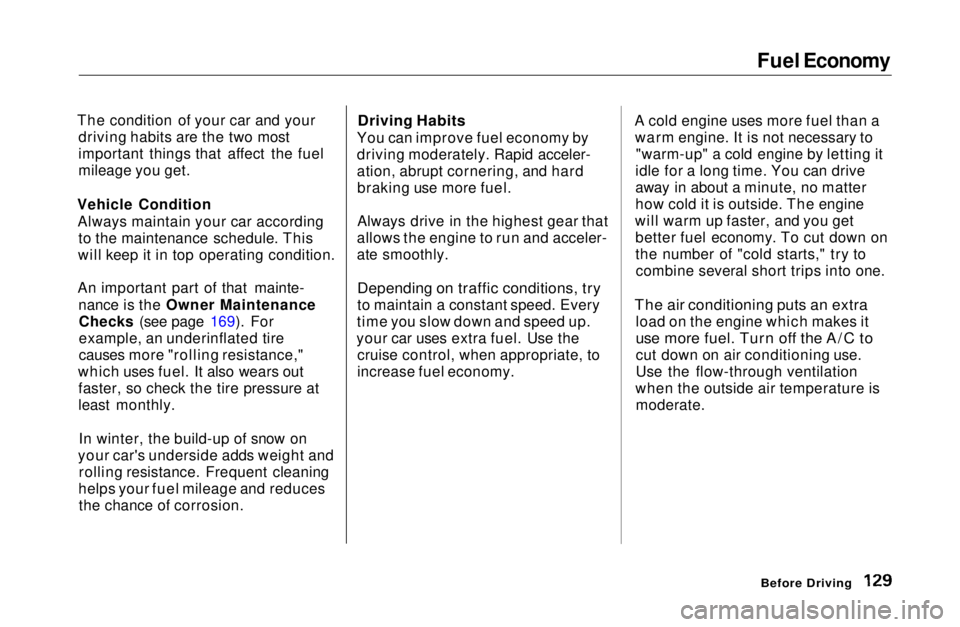
Fuel Economy
The condition of your car and your driving habits are the two most
important things that affect the fuel
mileage you get.
Vehicle Condition Always maintain your car according to the maintenance schedule. This
will keep it in top operating condition.
An important part of that mainte- nance is the Owner MaintenanceChecks (see page 169). For
example, an underinflated tire
causes more "rolling resistance,"
which uses fuel. It also wears out faster, so check the tire pressure at
least monthly.
In winter, the build-up of snow on
your car's underside adds weight and rolling resistance. Frequent cleaning
helps your fuel mileage and reduces the chance of corrosion.
Driving Habits
You can improve fuel economy by
driving moderately. Rapid acceler-
ation, abrupt cornering, and hard braking use more fuel.
Always drive in the highest gear that
allows the engine to run and acceler-
ate smoothly.
Depending on traffic conditions, try
to maintain a constant speed. Every
time you slow down and speed up.
your car uses extra fuel. Use the cruise control, when appropriate, to
increase fuel economy. A cold engine uses more fuel than a
warm engine. It is not necessary to "warm-up" a cold engine by letting it
idle for a long time. You can drive
away in about a minute, no matter
how cold it is outside. The engine
will warm up faster, and you get better fuel economy. To cut down on
the number of "cold starts," try tocombine several short trips into one.
The air conditioning puts an extra
load on the engine which makes it
use more fuel. Turn off the A/C to
cut down on air conditioning use.
Use the flow-through ventilation
when the outside air temperature is moderate.
Before DrivingMain Menu Table of Contents s t
Page 159 of 269
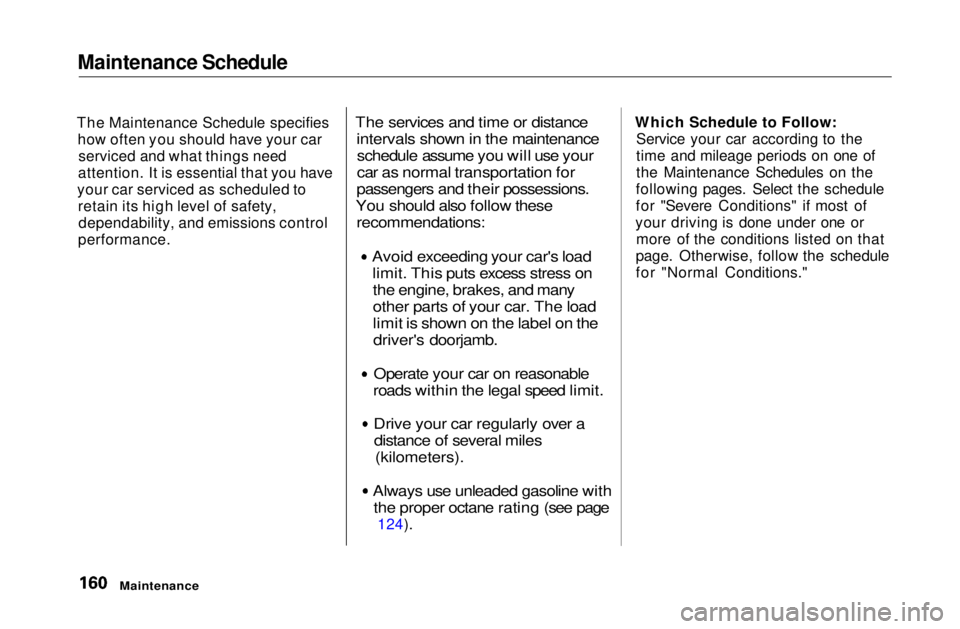
Maintenance Schedule
The Maintenance Schedule specifies how often you should have your carserviced and what things need
attention. It is essential that you have
your car serviced as scheduled to retain its high level of safety,dependability, and emissions control
performance.
The services and time or distance
intervals shown in the maintenanceschedule assume you will use your
car as normal transportation for
passengers and their possessions.
You should also follow these
recommendations:
Avoid exceeding your car's loadlimit. This puts excess stress onthe engine, brakes, and many
other parts of your car. The load
limit is shown on the label on thedriver's doorjamb.
Operate your car on reasonable
roads within the legal speed limit.
Drive your car regularly over adistance of several miles
(kilometers).
Always use unleaded gasoline with
the proper octane rating (see page
124). Which Schedule to Follow:
Service your car according to the
time and mileage periods on one of
the Maintenance Schedules on the
following pages. Select the schedule
for "Severe Conditions" if most of
your driving is done under one or more of the conditions listed on that
page. Otherwise, follow the schedule
for "Normal Conditions."
MaintenanceMain Menu Table of Contents s t
Page 160 of 269

Maintenance Schedule
Your authorized Honda dealer knows your car best and can provide competent, efficient service.However, service at a dealer is not
mandatory to keep your warrantiesin effect. Maintenance may be done
by any qualified service facility or person who is skilled in this type of automotive service. Keep all the
receipts as proof of completion, and
have the person who does the work
fill out the Maintenance Record. Check your warranty booklet for
more information. We recommend the use of Genuine
Acura parts and fluids whenever you have maintenance done. These aremanufactured to the same high-quality standards as the original
components, so you can be confidentof their performance and durability.
U.S. Vehicles:
Maintenance, replacement orrepair of emissions control
devices and systems may be done
by any automotive repair establishment or individual using
parts that are "certified" to EPAstandards. According to state and federal
regulations, failure to performmaintenance on the items marked
with # will not void your emissions warranties. However, Hondarecommends that all maintenance services be performed at the
recommended time or mileage
period to ensure long-term reliability.
MaintenanceMain Menu Table of Contents s t
Page 211 of 269
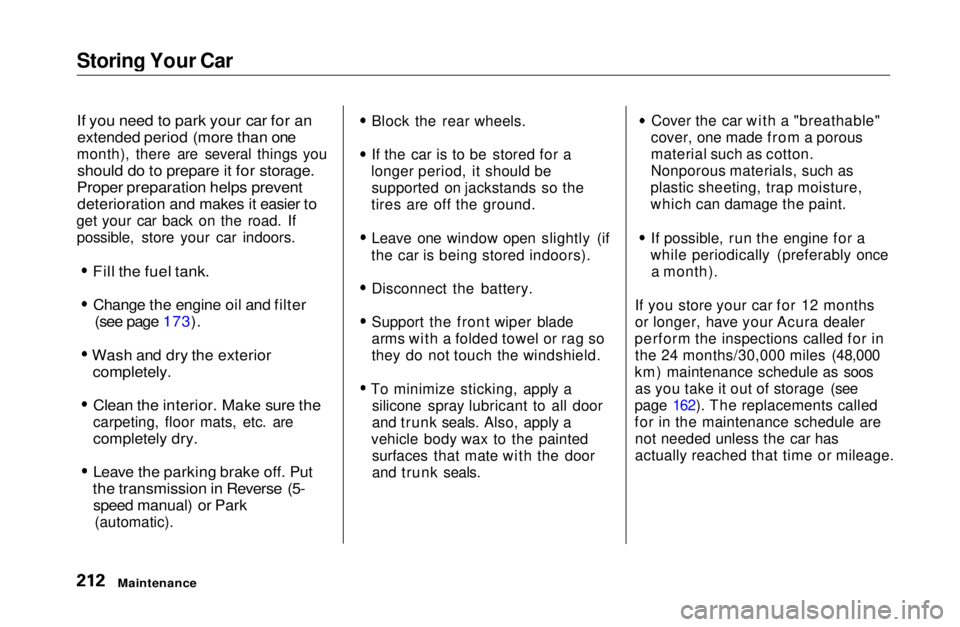
Storing Your Car
If you need to park your car for an
extended period (more than one
month), there are several things you
should do to prepare it for storage.
Proper preparation helps prevent
deterioration and makes it easier to
get your car back on the road. If possible, store your car indoors.
Fill the fuel tank.
Change the engine oil and filter
(see page 173).
Wash and dry the exterior
completely.
Clean the interior. Make sure the
carpeting, floor mats, etc. are
completely dry.
Leave the parking brake off. Put
the transmission in Reverse (5-
speed manual) or Park
(automatic). Block the rear wheels.
If the car is to be stored for a
longer period, it should be supported on jackstands so the
tires are off the ground.
Leave one window open slightly (if
the car is being stored indoors).
Disconnect the battery.
Support the front wiper blade
arms with a folded towel or rag so
they do not touch the windshield.
To minimize sticking, apply a silicone spray lubricant to all door
and trunk seals. Also, apply a
vehicle body wax to the painted surfaces that mate with the door
and trunk seals. Cover the car with a "breathable"
cover, one made from a porous
material such as cotton.
Nonporous materials, such as
plastic sheeting, trap moisture,
which can damage the paint.
If possible, run the engine for a
while periodically (preferably once a month).
If you store your car for 12 months
or longer, have your Acura dealer
perform the inspections called for in the 24 months/30,000 miles (48,000
km) maintenance schedule as soos as you take it out of storage (see
page 162). The replacements called
for in the maintenance schedule are not needed unless the car has
actually reached that time or mileage.
MaintenanceMain Menu Table of Contents s t
Page 252 of 269

Driving in Foreign Countries
Technical Information
If you are planning to take your
Honda outside the U.S. or Canada,
contact the tourist bureaus in the
areas you will be traveling in to find
out about the availability of unleaded
gasoline with the proper octane
rating.
If unleaded gasoline is not available,
be aware that using leaded gasoline in your Honda will affect perfor-
mance and fuel mileage, and damage
its emissions controls. It will no
longer comply with U.S. andCanadian emissions regulations, and
will be illegal to operate in North
America. To bring your car back into compliance will require the replace-
ment of several components, such as
the oxygen sensors and the three
way catalytic converter. These re- placements are not covered under
warranty.Main Menu Table of Contents s t
Page 257 of 269
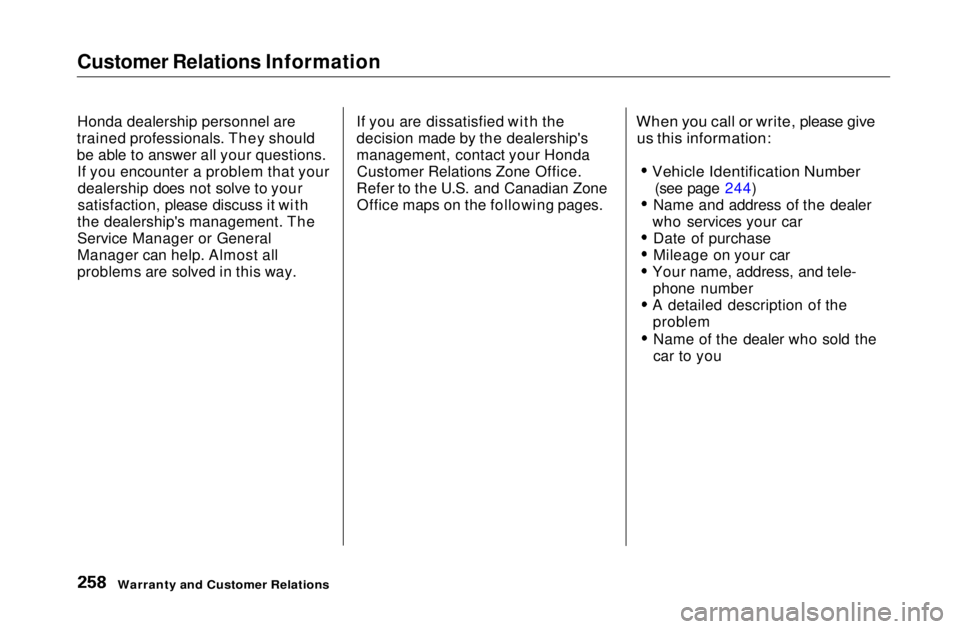
Customer Relations Information
Honda dealership personnel are
trained professionals. They should
be able to answer all your questions. If you encounter a problem that yourdealership does not solve to your
satisfaction, please discuss it with
the dealership's management. The
Service Manager or General
Manager can help. Almost all
problems are solved in this way. If you are dissatisfied with the
decision made by the dealership's
management, contact your Honda
Customer Relations Zone Office.
Refer to the U.S. and Canadian Zone Office maps on the following pages.
When you call or write, please give
us this information:
Vehicle Identification Number
(see page 244)
Name and address of the dealer
who services your car Date of purchase
Mileage on your car
Your name, address, and tele- phone number
A detailed description of the problem
Name of the dealer who sold the
car to you
Warranty and Customer RelationsMain Menu Table of Contents s t
Page 258 of 269

Warranty Coverages
U.S. Owners
Your new Honda is covered by these warranties:
New Car Limited Warranty — covers
your new vehicle, except for the battery, emissions control systemsand accessories, against defects in
materials and workmanship.
Emissions Control Systems Defects Warranty and Emissions
Performance Warranty — these two
warranties cover your vehicle's emis- sions control systems. Time, mileage,
and coverage are conditional. Please
read the warranty manual for exact information.
Original Equipment Battery Limited
Warranty — this warranty gives up
to 100 percent credit toward a
replacement battery. Seat Belt Limited Warranty — a seat
belt that fails to function properly is covered for the useful life of the
vehicle.
Rust Perforation Limited Warranty — all exterior body panels are
covered for rust-through from the
inside for the specified time period
with no mileage limit.
Accessory Limited Warranty —
Genuine Honda Accessories are
covered under this warranty. Time and mileage limits depend on the
type of accessory and other factors.
Please read your warranty manual
for details.
Replacement Parts Limited
Warranty — covers all Genuine
Honda replacement parts against
defects in materials and workman-
ship.
Replacement Battery Limited
Warranty — provides prorated
coverage for a replacement battery
purchased from a Honda dealer.
Replacement Muffler Lifetime
Limited Warranty — provides
coverage for as long as the pur- chaser of the muffler owns the car.
Restrictions and exclusions apply to
all these warranties. Please read the 1999 Honda Warranty Information
booklet that came with your car for precise information on warranty
coverages. Your Honda's original
tires are covered by their manufacturer. Tire warranty infor-
mation is in a separate booklet.
Canadian Owners
Please refer to the 1999 Warranty
Manual that came with your car.
Warranty and Customer RelationsMain Menu Table of Contents s t
Page 263 of 269
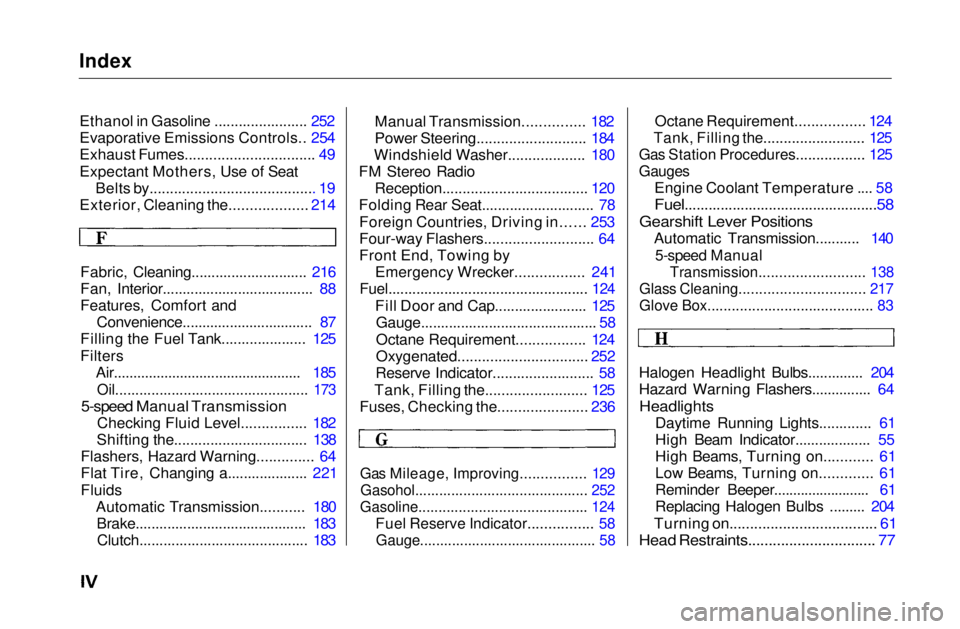
Index
Ethanol in Gasoline ....................... 252
Evaporative Emissions Controls.. 254
Exhaust Fumes................................ 49
Expectant Mothers, Use of Seat Belts by......................................... 19
Exterior, Cleaning the................... 214
Fabric, Cleaning............................. 216
Fan, Interior...................................... 88
Features, Comfort and Convenience................................. 87
Filling the Fuel Tank..................... 125
Filters Air................................................ 185
Oil................................................ 173
5-speed Manual Transmission
Checking Fluid Level................ 182
Shifting the................................. 138
Flashers, Hazard Warning.............. 64
Flat Tire, Changing a.................... 221
Fluids Automatic Transmission........... 180Brake........................................... 183Clutch.......................................... 183 Manual Transmission............... 182
Power Steering........................... 184
Windshield Washer................... 180
FM Stereo Radio Reception.................................... 120
Folding Rear Seat............................ 78
Foreign Countries, Driving in...... 253
Four-way Flashers........................... 64
Front End, Towing by Emergency Wrecker................. 241
Fuel.................................................. 124
Fill Door and Cap....................... 125Gauge............................................ 58
Octane Requirement................. 124
Oxygenated................................ 252
Reserve Indicator......................... 58
Tank, Filling the......................... 125
Fuses, Checking the...................... 236
Gas Mileage, Improving................ 129
Gasohol........................................... 252
Gasoline.......................................... 124
Fuel Reserve Indicator................ 58
Gauge............................................ 58
Octane Requirement................. 124
Tank, Filling the......................... 125
Gas Station Procedures................. 125
Gauges
Engine Coolant Temperature .... 58
Fuel................................................58
Gearshift Lever Positions
Automatic Transmission........... 140
5-speed Manual
Transmission.......................... 138
Glass Cleaning............................... 217
Glove Box......................................... 83
Halogen Headlight Bulbs.............. 204
Hazard Warning Flashers............... 64
Headlights
Daytime Running Lights............. 61
High Beam Indicator................... 55
High Beams, Turning on............ 61
Low Beams, Turning on............. 61
Reminder Beeper......................... 61
Replacing Halogen Bulbs ......... 204
Turning on.................................... 61
Head Restraints............................... 77Main Menu s t